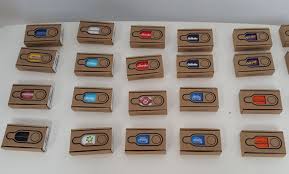The Amazon Dash button was a physical interface for digital purchases.
The Amazon Dash button was a physical interface for digital purchases.
Button of the month: Amazon Dash button
- Button of the month: Amazon Dash button
- For the vast majority of Amazon purchases, there is still no checkout lane, no aisles to navigate, no physical interactions at all:
- The Dash button was a fascinating product, representing Amazon's most blatant play to get into your physical space to sell you stuff.
- AS HARDWARE, THE BUTTONS ON THE DASHBOARD SEEMED TOO LIMITED
- In addition, for products that really benefited from the buttons (such as printers with specific cartridge requirements),
In today's digital age, it can sometimes feel like the hardware has taken a back seat to the software that drives the devices.
Button of the Month es una columna que analiza algunos de estos botones y enciende dispositivos tanto antiguos como nuevos para apreciar cómo interactuamos con nuestros dispositivos en un nivel físico y táctil y el funcionamiento del boton
Comprar en Amazon es una experiencia enormemente digital. Hasta los últimos años , no ha habido una forma física de ir y comprar cosas de Amazon.
For the vast majority of Amazon purchases, there is still no checkout lane, no aisles to navigate, no physical interactions at all:
el software "One Click" de la compañía elimina casi todas las barreras entre querer algo y comprarlo.
Los botones Dash, ahora difuntos, de Amazon, pequeños pods conectados a Wi-Fi con un solo botón que reordenarían un producto específico, debían cambiar eso cuando se introdujeron en 2015.
Ofrecieron una manifestación física de esa experiencia tradicional de Amazon: Compra lo que necesitas con un solo clic.
The Dash button was a fascinating product, representing Amazon's most blatant play to get into your physical space to sell you stuff.
Claro, los parlantes Echo y las tabletas Fire pueden acceder a la tienda de Amazon, pero no es su función principal de la misma manera que los Dash Buttons existían exclusivamente para comprar.
Es casi una idea extraña: los clientes salieron y compraron herramientas diseñadas específicamente para Amazon que solo le permiten comprar más cosas de Amazon.
También fue inteligente, envuelto en los atrevidos y coloridos logotipos de las marcas para las que fueron tus botones del tablero; un lobo del Amazonas escondido en la ropa de oveja de tu producto favorito.
Pero a pesar de eso, el botón Dash solo tuvo un poco de éxito. En el papel, estaba bien: un producto funcional que cerraba la brecha entre la tienda digital de Amazon y el mundo real.
¿Quedarte sin café o pañales? Simplemente presione el botón y más estará en camino.
Y la capacidad de colocar botones por los dispositivos que los necesitarían fue brillante, permitiendo a los clientes pedir más detergente tal como utilizaron el último en una carga de ropa, por ejemplo.
AS HARDWARE, THE BUTTONS ON THE DASHBOARD SEEMED TOO LIMITED
Pero los botones del tablero fallaron porque, como hardware, era demasiado limitado. En comparación con el sitio web de Amazon, el botón Dash no ofrecía una de las mejores comodidades de compras en línea:
poder comparar precios fácilmente y comprar lo que sea más barato.
Y si bien eso es genial para algo como Doritos, donde los imitadores simplemente no lo cortan, es menos útil para los artículos domésticos ordinarios,
como bolsas de basura, toallas de papel o jabón, donde las marcas son menos prioritarias que el precio.
También hubo problemas con el hecho de que los precios en Amazon tienden a fluctuar mucho, por lo que nunca podría estar realmente seguro de lo que pagaría en una prensa determinada (un hecho que vio los botones prohibidos en Alemania debido a las leyes de protección del consumidor que existen). ).
In addition, for products that really benefited from the buttons (such as printers with specific cartridge requirements),
los botones fueron víctimas de su propio éxito cuando los dispositivos inteligentes comenzaron a tomar el control: el servicio de rea bastecimiento del tablero de instrumentos de Amazon significaba
que los clientes no necesitaban un botón a medida. para pedir más tinta de impresora o filtros de agua, sus productos conectados a Wi-Fi ya podrían hacerlo por usted .

Y esa es realmente la autopsia de Dash, que siempre fue un recurso provisional. Además, se puede argumentar que Amazon tuvo éxito, de alguna manera:
Dash está muerto, pero el hardware, el software y los servicios de la compañía tienen un control aún mayor en su hogar que nunca antes. Simplemente no en forma de botón.
https://informaticacolectiva.com

Write us a comment: